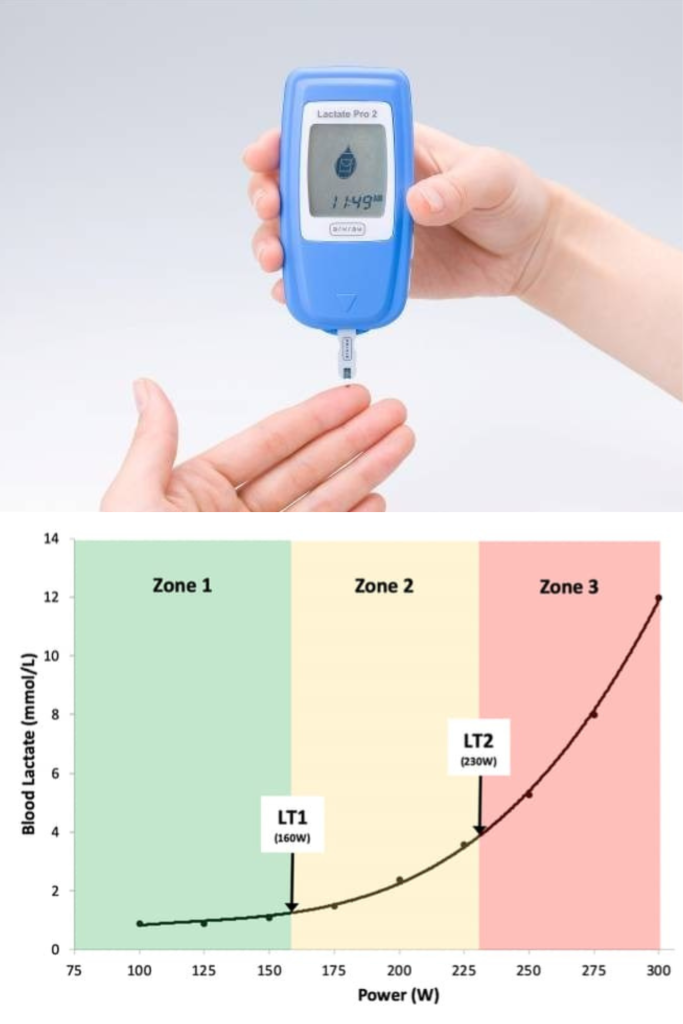What is Lactate Threshold?
A lactate threshold test measures the exercise intensity at which lactate begins to accumulate in your blood faster than it can be cleared. This point, known as the lactate threshold, is a key marker of endurance performance, indicating the transition from primarily aerobic to anaerobic energy systems.
Why Should I Take One?
- Optimise Training Zones: Identify your heart rate or power zones for more effective training.
- Improve Endurance: Train smarter to delay fatigue and sustain higher intensities for longer.
- Boost Performance: Tailor workouts to maximise speed, efficiency, and stamina.
- Track Progress: Monitor improvements in your fitness over time.
- Enhance Recovery: Learn to manage training intensity and avoid overtraining.
A lactate threshold test is ideal for athletes, endurance enthusiasts, and anyone looking to elevate their performance or improve fitness efficiently.
Who Should Take the Test?
- Endurance Athletes: Optimise heart rate zones for sustained effort.
- Competitive Athletes: Gain a competitive edge by refining training strategies.


Testing Phase
- Starting Point: Begin at a manageable intensity (walking, jogging, or cycling with low resistance).
- Incremental Increases:
- On the treadmill: Increase speed or incline every 1-3 minutes.
- On the Watt Bike: Gradually increase resistance or cadence in stages.
3.Continuous Monitoring:
- Blood Sampling: At the end of each stage, stop briefly for a few seconds for a finger-prick blood sample to measure lactate concentration.
- Track heart rate, speed, or power output during each stage.
Stopping Points
- The stopping point of a lactate threshold test is typically the point at which lactate begins to accumulate in the blood faster than it can be cleared.
- Lactate levels show a rapid increase between consecutive stages (the lactate threshold).
- The participant reaches a level of perceived exertion where continuing is unsustainable.
Cool-Down
- Perform 5-10 minutes of light activity to gradually reduce heart rate and blood pressure.
Results and Insights
Participants receive a detailed report, including:
- Lactate Threshold: The intensity (speed, power, or heart rate) where lactate begins to accumulate rapidly.
- Heart Rate Zones: Target zones for optimizing training intensity.
- Training Recommendations: Specific guidance to improve endurance, delay fatigue, and maximise performance.
As part of your appointment, we will walk you through your results, providing personalised recommendations and actionable steps to help you achieve meaningful improvements.
FAQ
How long does a Lactate Threshold Test take?
- The total appointment will be about 1 hour. The main exercise component of the test is typically 15-20 minutes in duration.
How should I prepare for the test?
- For best results, avoid food, tobacco, alcohol, and caffeine for at least 3 hours before testing.
- Wear comfortable exercise clothing suitable for treadmill or bike exercise.
How often should I take a Lactate Threshold test?
- It’s recommended to retest every 6-12 months or after significant changes in training, fitness level, or body composition.
Should I take the test on the treadmill or exercise bike?
- Choose the equipment that aligns with your primary sport or activity for the most relevant and actionable results. If unsure, contact us and we can help you decide.
- Treadmill: Best for runners, walkers, or weight-bearing activities; offers higher VO2 results but involves more joint impact.
- Exercise Bike: Ideal for cyclists, triathletes, or low-impact training; better for those with joint concerns or injuries.
Is the test suitable for beginners?
- Yes, the FatMax test is suitable for all fitness levels as it focuses on submaximal intensities rather than pushing you to exhaustion.
What are the differences & similarities between Max VO2, FatMax, and Lactate Tests?
| Aspect | Lactate Threshold | FatMax | Max VO2 |
|---|---|---|---|
| Purpose | Identifies the intensity where lactate starts to accumulate faster than it can be cleared. | Determines the intensity where fat burning is maximised. | Measures the maximum oxygen your body can use during exercise. |
| Key Reasons for Test | Optimise endurance performance and delay fatigue. | Assess fat-burning efficiency. | Assess aerobic fitness and overall cardiovascular performance limits. |
| Primary Metric | Blood lactate levels vs. exercise intensity | Fat-to-carbohydrate fuel utilization ratio | VO2 (oxygen uptake) and VCO2 (CO2 output) |
| Outcome | Optimise training zones to delay fatigue and improve endurance. | Identify heart rate zones for fat loss and energy efficiency. | Assess aerobic capacity and overall cardiovascular fitness. |
Each test provides valuable, specific insights, but combining them creates a holistic view of aerobic fitness, energy efficiency, and performance thresholds, allowing for highly targeted training and nutrition strategies.
